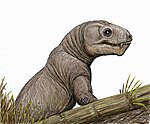| Qingtoushan Formation | |
|---|---|
| Stratigraphic range: Middle Permian, Roadian PreꞒ Ꞓ O S D C P T J K Pg N | |
| Type | Geological formation |
| Underlies | Sunan Formation |
| Overlies | Yaogou Formation |
| Thickness | Over 300 metres |
| Lithology | |
| Primary | Sandstone |
| Other | Mudstone |
| Location | |
| Region | Gansu |
| Country | |
| Extent | Qilian Mountains |
| Type section | |
| Named by | Liu et al |
| Year defined | 2012 |
The Qingtoushan Formation is a Middle Permian-age geologic formation in the Qilian Mountains of Gansu, China. It is known for its diverse tetrapod fauna known as the Dashankou fauna, which likely dates to the Roadian, and includes some of the oldest known therapsids. This formation was previously erroneously named as the Xidagou Formation, a name which applies to otherwise Triassic strata in the northern Qillian Mountains. The formation is over 300 metres thick, and primarily consists of purple-red coarse sandstones, with minor purple mudstone.
Paleobiota
Color key
|
Notes Uncertain or tentative taxa are in small text; |
Synapsida
| Genus | Species | Location | Stratigraphic position | Material | Notes | Images |
|---|---|---|---|---|---|---|
|
B. qilianicus |
A well-preserved skull | An anomodont | ||||
|
S. yumenensis |
A single skull (GMV 1601) | An anteosaurid dinocephalian | ||||
|
S. acidentatus |
A skull (IGCAGS V 361) and fragmentary jaw bones |
Jr. synonym of Sinophoneus yumenensis |
||||
|
R. dashankouensis |
Dashankou locality | A partial skull | A basal therapsid. |
Sauropsida
| Genus | Species | Location | Stratigraphic position | Material | Notes | Images |
|---|---|---|---|---|---|---|
|
B. zhengi |
A bolosaurid parareptile | |||||
|
G. qingtoushanensis |
A captorhinid |
Chronisuchia
| Genus | Species | Location | Stratigraphic position | Material | Notes | Images |
|---|---|---|---|---|---|---|
| Phratochronis | P. qilianensis | A Chroniosuchid | ||||
| Ingentidens | I. corridoricus | A Chroniosuchid |  |
Temnospondyli
| Genus | Species | Location | Stratigraphic position | Material | Notes | Images |
|---|---|---|---|---|---|---|
| Anakamacops | A. petrolicus | A dissorophid temnospondyl |  |
References
- Duhamel, A.; Benoit, J.; Rubidge, B. S.; Liu, J. (August 2021). "A re-assessment of the oldest therapsid Raranimus confirms its status as a basal member of the clade and fills Olson's gap". The Science of Nature. 108 (4): 26. doi:10.1007/s00114-021-01736-y. ISSN 0028-1042. PMID 34115204. S2CID 235403632.
- Liu J, Qinghua S, Keqin S, Lu L (2012) The horizon of Dashankou Fauna and the Permo-Triassic strata in northern Qilian area, China. Vertebr Palasiat 50(4):373–381 (In Chinese)
- ^ Liu, J.; Rubidge, B.; Li, J. (2009). "A new specimen of Biseridens qilianicus indicates its phylogenetic position as the most basal anomodont". Proceedings of the Royal Society B. 277 (1679): 285–292. doi:10.1098/rspb.2009.0883. PMC 2842672. PMID 19640887.
- ^ Kammerer, C.F. (2011). "Systematics of the Anteosauria (Therapsida: Dinocephalia)". Journal of Systematic Palaeontology. 9 (2): 261–304. doi:10.1080/14772019.2010.492645. S2CID 84799772.
This paleontological site article is a stub. You can help Misplaced Pages by expanding it. |
This Chinese location article is a stub. You can help Misplaced Pages by expanding it. |




